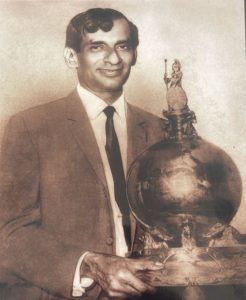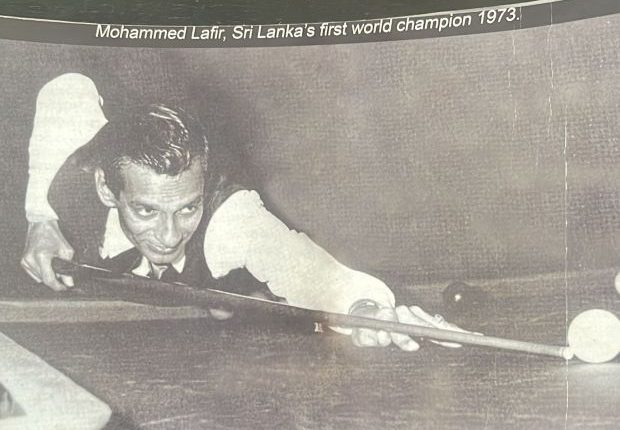Sri Lanka’s epic World Cup triumph in Billiards
Reflecting how Lafir came to be crowned monarch of the green baize 50 years ago
By a Special Correspondent
It is almost three decades since a cricket-crazy nation celebrated the World Cup triumph of ‘Arjuna and his boys’ in 1996. This triumph united a fractured country with even the guns going silent. The euphoria and hysteria which followed, inevitably transformed the status of the gentleman’s game with all and sundry wanting a piece of the pie, resulting in the commercialization of the sport.
There was no such fanfare when MJM Lafir became world billiards champion in 1973 and brought glory to Sri Lanka, establishing himself as the king of the green baize, beating the more fancied Indian cueists Satish Mohan and Michael Ferreira in their backyard in Bombay.
A true patriot, he spurned offers to become professional when he emerged runner-up in the 1969 championship in London. After winning the crown, he was promised riches by those in authority but like most champions, he passed away at 51, a dejected man.
“Many used me, and if it had not been for my faith in God and my resolve to win, I would not have come so far,” he was reported to have confided in his last media interview in 1981.
After his first world-class win over the South African Mannie Francisco in the 1967 event in Colombo, he is reported to have said, “My hair stood on end all over my body. I suddenly shouted ‘Allah’ and thanked Him for my victory”.
Messenger Street was renamed in his memory, a postage stamp was issued to mark his monumental feat and Asian Snooker champions have been receiving the MJM Lafir Challenge Trophy since 2006. But to many Sri Lankans, his triumph is just a distant memory even for the body governing the sport of billiards and snooker.
Fading memories notwithstanding, revisiting how this genial maestro of the green baize achieved his date with destiny half a century ago is a fascinating tale. As is the tale of how he fulfilled a prophecy after displaying wizardry with the cue from the age of seven, following in the footsteps of his father who was a player of some repute.

“Mohammed Lafir, who learnt to play Billiards on his family dining table using a broomstick for a cue, marbles for balls, a sarong for a cloth and a cycle tube for cushions, won the World Amateur Billiards Championship at the Cricket Club of India, Bombay, winning all his nine matches and making a new world record, break of 859,” wrote Clive Everton, Editor of Snooker Scene on Lafir’s magnificent triumph.
“In many ways, it was a surprise win, not only because Satish Mohan, the Indian champion, started as odds-on favourite but because Lafir, 8th out of 12 in the World Open in New Zealand last year and a poor fourth in the World Amateur in Malta in 1971, seemed to be falling away from the form which had taken him into second place in the 1967 event in Colombo and joint second in the 1969 championship in London,” wrote Welshman Everton, who finished fifth in the 1973 championship.
In another analysis, Everton described how Lafir held sway with the ‘Postman’s Knock’ a scoring system based on manoeuvring the object which lay on the top cushion directly behind the red.
“In Bombay, a few whirling fans high in the asbestos roof did little to alleviate an outside temperature in the 90s. But far more important than the marginal advantages of these playing conditions and local diet, was the fact that for the previous six months, Lafir had been playing the best billiards of his life,” Everton observed.
“Not only was the outside temperature in the 90s about what he is used to at home in Colombo, but Indian food suited his digestion. After competing in All-India Championships for some 15 years, he was also thoroughly familiar with Indian conditions. Perhaps even more to the point was the fact that he had been playing the best Billiards of his life in the preceding six months, with 27 breaks over 500, including one of 879,” he wrote, adding, “Lafir also received the priceless gift of a set of Super Crystalate balls from his great friend Bert Demarco, who had earlier sent him £50 to help him keep going.”
What about the crucial mental factors?
First, his extensive 15-year experience in the All-India Championships and 10 years in the World Billiards and Snooker Championships made him the most seasoned competitor. Second, the confidence gained from a series of significant breaks played a pivotal role. Third, the comfort of a congenial diet, climate, and familiar playing conditions contributed to his mental composure.
Fourth, Lafir’s peace of mind was deeply connected to his religious convictions. “Before every match, I think of God,” Lafir is reporting as saying. And Everton quotes him as saying, “After a match, whether I win or lose, I never fail to thank God. I rely on God’s help. If I play with that need, I feel at peace. Of course, I must also try. If I close my eyes and say ‘God help me’ without taking action, that is foolishness.”
Notably, three of Lafir’s match times were adjusted to allow him to attend the mosque.
The convergence of these success factors occurred amidst the pressure of crowd expectations, which affected the efforts of both Satish Mohan and Michael Ferreira, who finished second and third.
Lafir set a new world record four hours aggregate of 2,850 points against Scotsman Luigi Umberto Demarco and topped it with a new world record amateur break of 859 in 49 minutes 47 seconds against New Zealander Eric Simons, surpassing Australian Bob Marshall’s mark of 702.
In 1974, Lafir recorded a rare double of winning the national billiards and snooker titles – the fourth cueist to register the double. The previous three were Wilson Jones (1960), Robert Marshall (1962) and Satish Mohan (1968). Lafir won the snooker title for the seventh time having first won it in 1957. This was his first victory in billiards – the closest he had got to it was in 1965 when he had finished runner-up.
For a nation obsessed with cricket and the 1996 World Cup triumph, Lafir’s incredible feat remains just a postage stamp. They forget the fact that Lafir was Sri Lanka’s first-ever world champion. A player who was lyrical on the green baize and had the gentlest touch with a cue in hand, Lafir was a consummate professional during an amateur era. He was a sporting legend born ahead of his time and there will never be another like him.
MJM Lafir Timeline
Mohamed Junaid Mohamed Lafir was born on May 27, 1929, to a family that consisted of two brothers and one sister. Educated at Hameed Al Husseinie Maha Vidyalaya, he started snooker at age seven using a broomstick as a cue and lime fruits as balls, on the family dining table.
National
He was crowned the National Snooker Champion 17 times, and the National Billiards Champion 16 times.
He accomplished a double ie. Billiards and Snooker titles 13 times in Sri Lanka and is the holder of the highest break in billiards in Sri Lanka – 500 unfinished in 20 minutes made in the Nationals of 1973.
International
He was crowned All India Snooker Champion 8 times, which is still a record in Indian Nationals. He was All India Billiards Champion in 1978, and Western India Snooker Champion 5 times.
World
Billiards
He was Runner-Up in the 1967 World Billiards Tournament in Colombo, the 1969 World Billiards Tournament in London, and secured 4th place in the 1971 World Billiards Tournament in Malta.
He was World Champion in the 1973 World Billiards Tournament in India – making highest break of 859 in 49 minutes and 47 seconds, which is still the existing world record.
He was placed 4th in the 1979 World Billiards Tournament in Colombo.
Snooker
He was placed 3rd in the 1963 World Snooker in Calcutta, 4th in the 1966 World Snooker in Karachi, became a Quarter Finalist in the 1968 World Snooker in Australia, Semi-Finalists in the 1970 World Snooker in Scotland and was placed 7th in the 1974 World Snooker in Ireland –
Mohamed Junaid Mohamed Lafir expired on April 26, 1981, aged 52.
-ENCL



Comments are closed, but trackbacks and pingbacks are open.